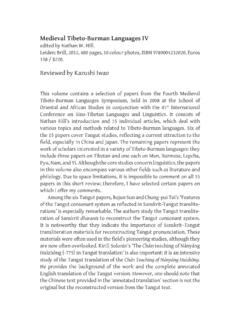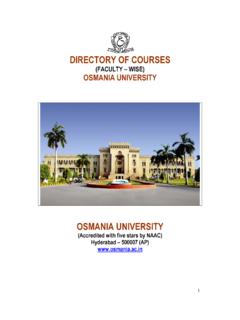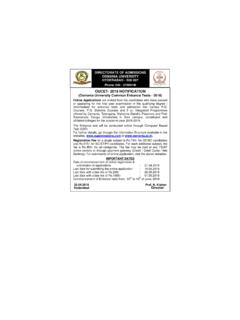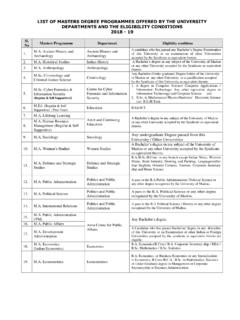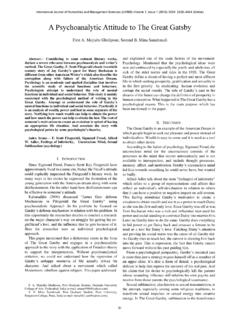Transcription of Tribes of India - Digital Himalaya
1 Preferred Citation: von F rer-Haimendorf, Christoph. Tribes of India : The Struggle for Survival. Berkeley: University of California Press, c1982 1982. :/13030/ft8r29p2r8/ Tribes of IndiaThe Struggle for SurvivalChristoph von F rer-HaimendorfUNIVERSITY OF CALIFORNIA PRESSB erkeley Los Angeles Oxford 1982 The Regents of the University of CaliforniaToN. V. Raja Reddi and Urmila Pinglein memory of our journeysin tribal countryPreferred Citation: von F rer-Haimendorf, Christoph. Tribes of India : The Struggle for Survival. Berkeley: University of California Press, c1982 1982. :/13030/ft8r29p2r8/ToN. V. Raja Reddi and Urmila Pinglein memory of our journeysin tribal countryPreface xi This book tells of observations among Indian tribal populations spanning the period from 1940 to 1980.
2 Ever since1936, when a study of the Konyak Nagas marked the beginning of my career as an anthropological field-worker, Ihave maintained contacts with Indian tribesmen. True, there were years when I concentrated on the study of themountain peoples of Nepal, but even then I paid periodic visits to some of the tribal areas of India , and thisenabled me to keep abreast of current in 1976 I retired from the Chair of Asian Anthropology at the University of London and could devote more time to fieldwork, I decided to undertake a systematic investigation of social and economic changesaffecting the tribal societies which I had studied in the 1940s. A grant from the Social Science Research Council ofGreat Britain, as well as subsidiary awards from the Leverhulme Trust Fund and the Wenner-Gren Foundation forAnthropological Research, provided the material basis for this project, which included also the funding of parallelresearch by my young colleague Dr.
3 Michael Yorke. It is to be hoped that in future years Michael Yorke will returnto the same tribal area, and thus extend the period of observation from forty to sixty or perhaps even seventyyears. The School of Oriental and African Studies, which provided the administrative framework for the project,will preserve the documentation, storing all my field notebooks and diaries from the years 1940 to 1980, as wellas photographic assistance from the Indian Council of Social Science Research enabled Mr. Jayaprakash Rao of the Osmania University in xii Hyderabad to participate in the project by undertaking a detailed study of the present condition of the Konda Reddis, a tribe of Andhra Pradesh which figured prominently in my research forty years earlier.
4 His contribution tothe volume (chapter 10) provides an Indian view of the problems of tribal populations. Both he and Michael Yorke,the author of chapter 9, are solely responsible for their contributions, which do not necessarily coincide in alldetails with my book is the third of three volumes which have so far resulted from the project, the first two being The Gonds of Andhra Pradesh: Tradition and Change in an Indian Tribe (Delhi and London, 1979) and A Himalayan Tribe: From Cattle to Cash (Delhi and Berkeley, 1980), and it is planned that additional publications originating from the project will follow in due realistic and unbiased analysis of the present situation of the Indian Tribes must inevitably contain some references to the failures as well as the successes of government policies and include also some criticism of thoseresponsible for the misfortunes of many tribal communities.
5 Such outspoken criticism may be consideredinappropriate on the part of an observer who throughout his fieldwork has benefited from the assistance ofnumerous government officials. Yet no good purpose can be served by turning a blind eye to corrupt practices andthe resulting failures of policies, thereby distorting the picture of the true conditions of tribal populations. Mydecision to choose frankness rather than diplomacy and circumlocution in the assessment of the actions ofgovernment departments in no way diminishes my gratitude for the many facilities offered to me by thegovernments of Andhra Pradesh and Arunachal am particularly appreciative of the cooperation of the staff of the Tribal Research Institute in Hyderabad, whose Director Dr.
6 D. R. Pratap furthered my work in many ways during the years my wife and I spent in AndhraPradesh. I take this opportunity to express also our gratitude to Mr. N. V. Raja Reddi, whose generous hospitalitywe enjoyed both in his house in Bhimaram and on two tours in Maharashtra and the Bastar District of MadhyaPradesh. The interest and the pleasure of these tours were greatly enhanced by the company of Dr. Urmila Pingle,whose genetic and dietary research among the Tribes of the area has opened many new detailed tribute to all those who helped our work in Arunachal Pradesh in 1978 is contained in the preface to A Himalayan Tribe . In 1980 we had the good fortune of returning to the Subansiri District, as well as of visitingpart of Kameng District, including the Tawang Subdivision.
7 In connection with this tour I would like to express ourthanks to Mr. R. N. Haldipur, Lieutenant Governor of Arunachal Pradesh, and to Mrs. Haldipur, whose warmhospitality my wife and I xiii enjoyed on more than one occasion. Equally cordial was the welcome of the present Collector of Subansiri District,Mr. L. Sharma, whose help greatly facilitated my work. A special word of thanks is also due to Mr. P. Ette, CircleOfficer of Raga, who went out of his way to assist us in our investigations among the Hill Miris of his circle. InKameng District we received the unstinting support of all the district officers and particularly of the Collector, P. Kelkar, who generously provided us with transport at a time when motor-fuel was in short supplythroughout Northeast India .
8 Once again Mr. B. B. Pandey of the Research Department accompanied us on ourentire tour in Arunachal Pradesh, and it is a pleasant duty to express our gratitude for his assistance , I wish to thank Mr. M. L. Kampani of the Ministry of Home Affairs and Mr. I. P. Gupta, Chief Secretaryto the Government of Arunachal Pradesh, for piloting our application for permission to undertake research in theSubansiri and Kameng districts through the complicated official 1981 1 Introduction: The Ethnographic SceneOne phenomenon inherent in the nature of the plural society of the Indian subcontinent is the coexistence oftenin a narrow space of populations varying greatly in the level of material and intellectual and eventual harmonization are the two possible outcomes of such a state of affairs, and this bookfocusses on the social problems created by the mounting influence of economically advanced and politicallypowerful groups on autochthonous societies which persisted until recently in an archaic and in many respectsprimitive life-style.
9 A full understanding of the disruption caused by this impact within the whole fabric of tribal lifecannot be gained from generalizations embracing the totality of the forty millions of Indian tribal populations. Thediversity of ethnic groups and cultural conditions is so great that such an approach would be impracticable, and itis for this reason that I have concentrated on a series of microstudies, each dealing with a specific tribal societyand with particular problems cognate to the process of social anthropologically interested Indian readers will have no difficulty in visualizing the Tribes mentioned in the appropriate geographic and cultural context, those unfamiliar with the Indian ethnographic scene may well beconfused by the kaleidoscopic pattern of tribal societies from which I have chosen concrete examples to illustratecontemporary developments among the tribesmen of the two regions best known to me.
10 Andhra Pradesh andArunachal the risk of repeating what I have written in earlier publications, many now out of print, I propose thereforeto set the scene with a 2 catalogue raisonn describing briefly the various ethnic groups whose members appear as dramatis personae inthe pages of this book. For the convenience of the reader wishing to probe deeper into the cultural background ofthe individual Tribes , I have appended to each of the ethnographic vignettes a bibliography listing the mainanthropological sources containing information on the group in question. To forestall any accusation ofegocentricity, I may mention that in the case of several Tribes , such as the Chenchus and Apa Tanis, fewpublished ethnographic data are available apart from the results of my own field of the DeccanChenchusDuring the Pal olithic Age, the vast forests and park-lands of South India were inhabited by bands of nomadicpeople, who lived by hunting and the gathering of wild fruits, tubers, and edible roots.


